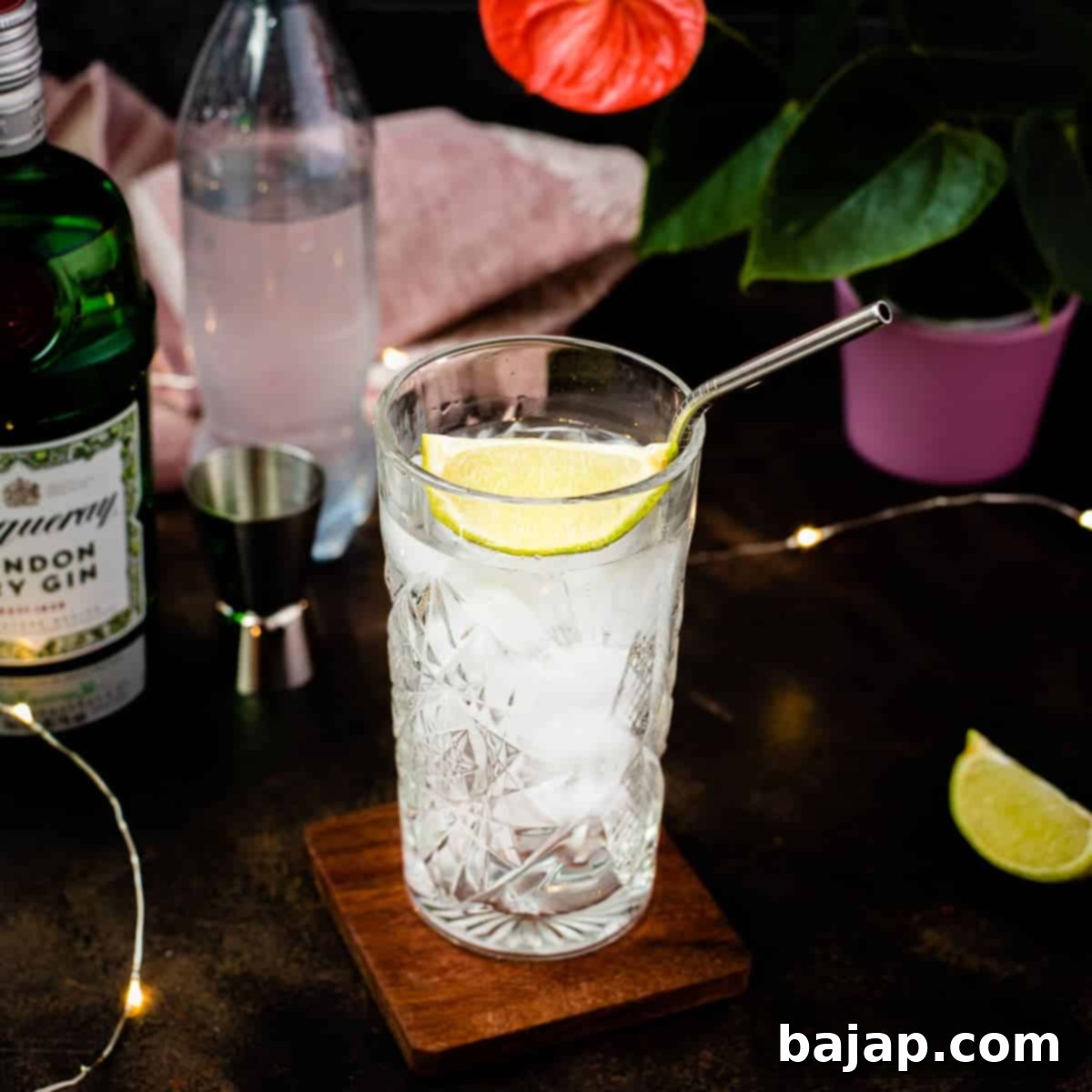The Ultimate Guide to Gin & Tonic: History, Types, Pairings & Perfect Recipe
There’s nothing quite like the refreshing, crisp gin and tonic on a hot summer’s day. This beloved cocktail remains a popular choice around the world, celebrated for its versatility and perfectly balanced flavor profile. Whether you’re a seasoned enthusiast or new to the craze, this comprehensive guide will tell you everything you need to know to truly appreciate and craft the ultimate gin and tonic experience!
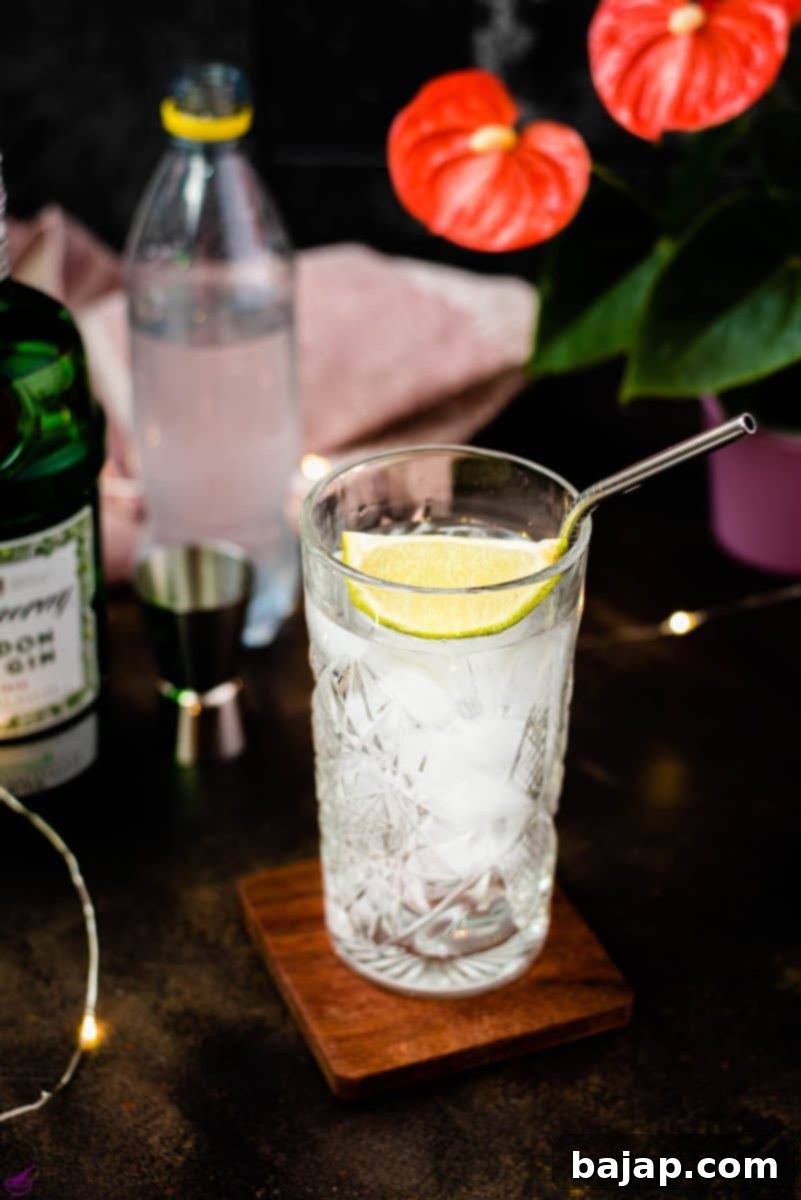
National Gin and Tonic Day is celebrated on April 9th each year!
A Brief History of Gin & Tonic
The story of gin and tonic is rich and surprising, dating back centuries before it became the popular cocktail we know today. Its origins are deeply intertwined with medicine and exploration.
The Medicinal Roots of Gin: Jenever and “Dutch Courage”
Long before it graced cocktail glasses, gin was primarily used for its perceived medicinal properties. The spirit’s lineage can be traced back to 13th-century Dutch monks who began distilling a juniper-flavored spirit called “jenever.” Initially, jenever was believed to cure ailments, even the plague. It wasn’t until the 17th century, during the Eighty Years’ War for Dutch independence, that jenever gained wider recognition. British soldiers fighting alongside the Dutch were given shots of this spirit to calm their nerves before battle, famously coining the term “Dutch Courage.” They quickly acquired a taste for it and brought it back home to Britain.
The London Gin Craze: From Medicine to Mayhem
Back in Britain, gin production soared. It was easier to distill and significantly cheaper than beer, leading to its widespread popularity, especially among the working class in London. This period, known as the “London Gin Craze” (roughly 1688-1751), saw an explosion in gin consumption, which was unfortunately often poorly distilled and unregulated. This led to serious social problems, crime, and public health issues, vividly depicted in William Hogarth’s famous print “Gin Lane.” The government eventually intervened with various Gin Acts to control its production and sale, ultimately leading to higher quality and more regulated distillation methods.
Tonic Water: A Lifesaver from Malaria
Around the same time, another key ingredient for our beloved cocktail was making its way into history: tonic water. Its origins can be traced to South America, where the bark of the cinchona tree was discovered to contain quinine, an effective treatment for malaria. British officers and soldiers stationed in India, a region plagued by malaria, were prescribed quinine. However, the bitter taste of quinine was highly unpalatable. To make it more drinkable, they began mixing the quinine powder with water, sugar, and often lime. The invention of carbonated water in the 18th century by Johann Jacob Schweppe further refined this mixture, leading to the commercial production of tonic water.
The Birth of the Gin & Tonic
It was in India that these two distinct histories converged. British officers, already accustomed to their daily quinine dose, started adding a splash of their local gin to the mixture for an “added kick” and to further mask the bitterness of the quinine. This practical medicinal concoction quickly evolved into the refreshing and iconic gin and tonic cocktail we cherish today. The blend of bitter quinine, botanical gin, and zesty lime proved to be a perfect synergy.
Prohibition Era and Beyond
The gin and tonic’s popularity continued to grow, even thriving during the Prohibition Era in the United States. “Bathtub Gin,” often of dubious quality, was made at home, and its harsh flavors were frequently disguised with citrus like lime, orange, and lemon, and mixed with tonic water. This further cemented citrus as a common garnish for the cocktail. Today, the gin and tonic remains a global favorite, constantly evolving with new craft gins and tonic waters, yet always honoring its rich and flavorful past.
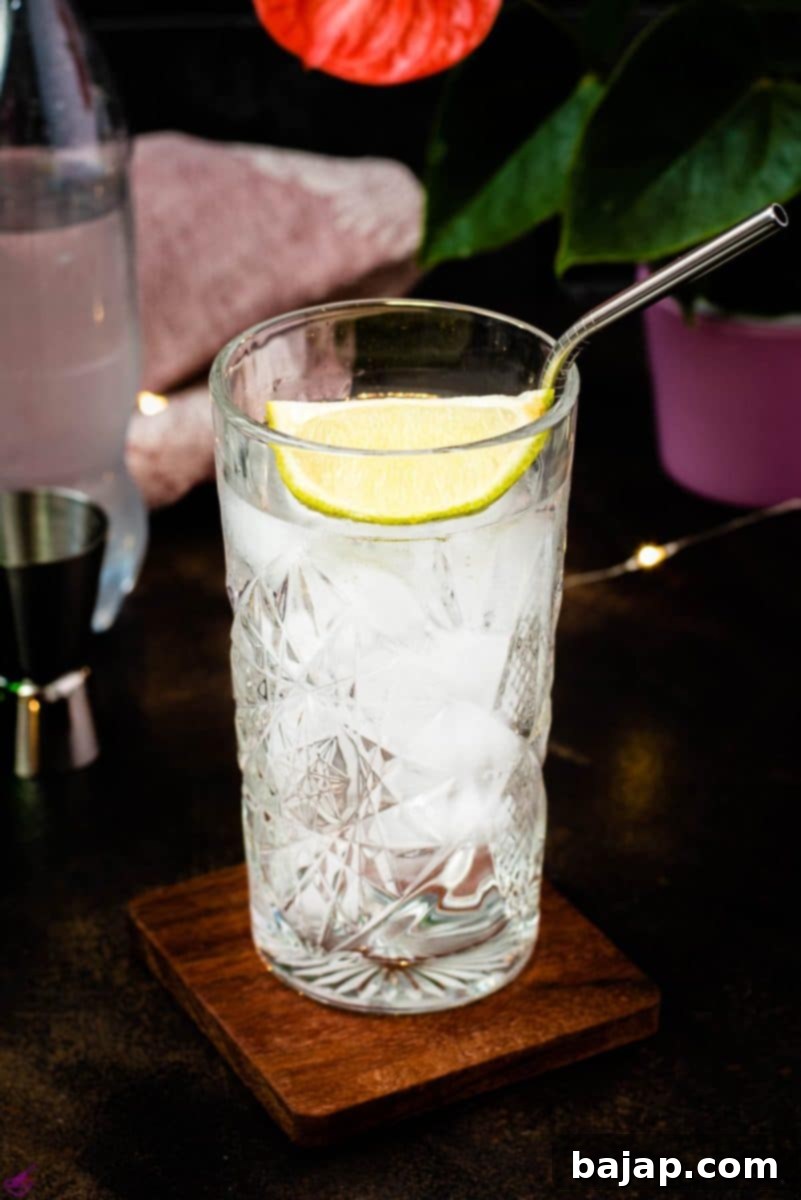
Different Types of Gin
While all gins are required to be flavored with juniper berries, the world of gin is far more diverse than many realize. Beyond juniper, various botanicals and distillation methods give each type its unique character, aroma, and flavor profile. Understanding these differences is key to finding your perfect gin for a gin and tonic. There are four main categories of gin, each offering a distinct experience.
London Dry Gin
London Dry is arguably the most popular and recognizable style of gin. Despite its name, it doesn’t have to be produced in London; rather, “London Dry” refers to a specific distillation method and quality standard. These gins are distilled without any artificial flavorings or sweeteners added after distillation, resulting in a crisp, clean, and often juniper-forward taste. The distillation process was standardized in the 19th century as a response to the “Gin Craze” to ensure higher quality and purity.
London Dry gins are renowned for their prominent piney juniper notes, often complemented by citrus (lemon, orange peel) and various spices (coriander, angelica root). They are the go-to choice for a classic gin and tonic, offering a bold and invigorating flavor.
Bombay Sapphire
With its iconic blue bottle, Bombay Sapphire is instantly recognizable. It’s known for its bright, aromatic profile, featuring a slightly sweeter, smoother taste compared to some other London Dry gins. Its unique vapor infusion process brings out delicate floral and citrus notes alongside the juniper.
Typically $20 USD
Tanqueray Gin
Tanqueray Gin is another globally recognized brand of London Dry gin, famous for its distinctive, bold juniper-forward flavor. It offers pronounced notes of pine and hints of lemon zest, making it a robust base for any cocktail. When using Tanqueray Gin, a twist of lemon peel can beautifully enhance its inherent citrus characteristics.
Typically $25 USD
Beefeater London Dry Gin
Beefeater is one of the few historical London Dry gins still distilled in London, specifically in Kennington. Its recipe has remained largely unchanged for over 200 years, ensuring a consistent and classic profile. Beefeater is celebrated for its clean, crisp taste, marked by strong juniper and bright citrus notes, offering a refreshing and classic gin experience.
Typically $20 USD
Old Tom Gin
Old Tom gin was incredibly popular in 18th-century England, serving as a bridge between the heavily botanical, often rustic, jenever and the refined London Dry gin. Its popularity waned significantly for two centuries but has seen a delightful resurgence with the craft cocktail movement. The defining characteristic of Old Tom gin is its slight sweetness, which can vary depending on the distiller.
There’s no single definitive recipe for Old Tom gin. Some distillers may age it briefly, others add a touch of sugar or licorice root to achieve the characteristic sweetness. This style is often richer and more aromatic than London Dry, making it excellent for classic cocktails like the Tom Collins or Martinez, and it also adds an interesting twist to a gin and tonic for those who prefer a mellower profile.
Hayman’s Old Tom Gin
Hayman’s Old Tom Gin exemplifies the style with its balanced sweetness. While sweet, it maintains a complexity with peppery top notes and strong undertones of juniper and citrus, culminating in a smooth, well-rounded finish. It’s a versatile choice for both classic and modern cocktails.
Typically $25 USD
Hammer & Son Old English Gin
For those seeking an Old Tom gin that balances sharpness with sweetness, Hammer & Son Old English Gin is an excellent option. It features a prominent juniper foundation, complemented by distinct citrus notes, making it a vibrant and flavorful choice for a gin and tonic with a twist.
Typically $25 USD
Plymouth Gin
Plymouth Gin is unique in that it is both a style and a protected geographical indication (PGI). It can only be made in Plymouth, England, at the historic Black Friars Distillery, where it has been continuously produced for over 230 years. This style is generally drier than Old Tom but less juniper-dominant than London Dry. Its botanical blend typically includes more root botanicals, giving it an earthier and slightly more aromatic profile.
Plymouth Gin is known for its full-bodied flavor, with a harmonious balance of juniper, earthy notes, and a hint of citrus zest. It’s a smoother, often softer gin, making it a favorite for cocktails where a less aggressive gin profile is desired, such as a Martini or a more mellow gin and tonic.
Plymouth Gin
If you appreciate complex, earthy flavors, Plymouth Gin will captivate your palate. It offers a distinctive piney aroma coupled with a zesty touch, featuring notes of juniper, cardamom, and other unique botanicals that comprise its closely guarded recipe. Its smooth finish makes it a truly sophisticated gin.
Typically $35 USD
Contemporary / New Western / New American Gin
This category represents a modern evolution in the gin world, often referred to as Contemporary, New Western, or New American gin. These gins challenge the traditional juniper-forward dominance of London Dry by giving equal, or even greater, prominence to other botanicals. Distillers experiment with a wide array of ingredients, focusing on floral, citrus, spice, or herbaceous notes. This results in incredibly diverse flavor profiles that can range from light and floral to bold and peppery, opening up new possibilities for gin and tonic enthusiasts seeking a unique experience.
Brands like Aviation, Bluecoat, and St. George are pioneers in this space, creating gins that emphasize botanicals like lavender, rose, cucumber, or exotic spices. These gins are perfect for those who enjoy exploring complex and innovative flavors in their cocktails.
Bluecoat American Dry Gin
Bluecoat American Dry Gin immediately impresses with its sweet aromatics and soft, earthy juniper notes. It’s renowned for its smooth and complex character, culminating in a bright and clean finish. This gin is a testament to the versatility of American craft distillation.
Typically $25 USD
Aviation Gin
Popularized by actor Ryan Reynolds, Aviation Gin is a must-try for its exceptional botanical blend. It features a delicious infusion of cardamom, coriander, French lavender, anise seed, sarsaparilla, juniper, and two types of orange peel. This complex blend creates a wonderfully smooth and aromatic gin that stands out in any cocktail.
Typically $40 USD
St. George Botanivore Gin
This gin is celebrated for its exquisite balance of tangy citrus, bright hops, fresh herbs, and exotic spices. St. George Botanivore Gin is often described as complex and bright, blending classic gin touches with a unique and innovative character. It’s a truly distinctive gin for the adventurous palate.
Typically $30 USD
Different Types of Tonic Water
The choice of tonic water is just as crucial as the gin itself in crafting a perfect gin and tonic. Tonic water provides the balance of bitterness and sweetness, and its own subtle botanicals can either complement or clash with your chosen gin. From classic, affordable options to premium craft varieties, understanding the different types of tonic water will elevate your G&T experience.
Classic and Affordable Tonic Waters
These are the go-to choices for many, offering a reliably crisp and refreshing base for your gin and tonic. They tend to be sweeter and have a more pronounced quinine bitterness.
Schweppes Tonic Water
Founded in 1783, Schweppes is known as the world’s first soft drink and has a rich history. It offers a classic, effervescent profile with a distinct quinine bitterness and a noticeable sweetness. It’s an affable and widely available option that won’t break the bank, making it a staple for many G&T drinkers.
Typically $1.50 USD per Liter
Canada Dry Tonic Water
Canada Dry Tonic Water is a popular choice for those who enjoy its slightly milder bitterness and refreshing quality. It’s also traditionally known for its ability to settle an upset stomach, making it a versatile mixer that’s enjoyable even on its own. Its balanced flavor profile works well with a variety of gins.
Typically $2.50 USD per Liter
Premium and Craft Tonic Waters
For those looking to elevate their gin and tonic, premium tonic waters offer a more refined and complex experience. These often feature natural ingredients, reduced sugar, and unique botanical blends designed to complement high-quality gins.
Top Note Classic Tonic Water
If you’re seeking a more sophisticated mixer, Top Note Classic Tonic Water is an excellent craft option. Relatively new to the market, it’s made from all-natural quinine bitters and features bright top notes of lime zest. This tonic provides a refreshing and nuanced backdrop, perfect for showcasing the botanicals of your chosen gin.
Typically $30 USD for a 16-Pack
Fever-Tree Refreshingly Light Premium Indian Tonic Water
Fever-Tree Refreshingly Light Premium Indian Tonic Water is a trendy and highly regarded choice among gin and tonic enthusiasts. While a bit more expensive than standard brands, its premium quality and lighter profile are well worth it. It’s crafted with natural ingredients, offering a delicious, crisp, and less sweet taste that beautifully complements a wide range of gins without overpowering their unique characteristics.
Typically $34 USD for a 24-Pack
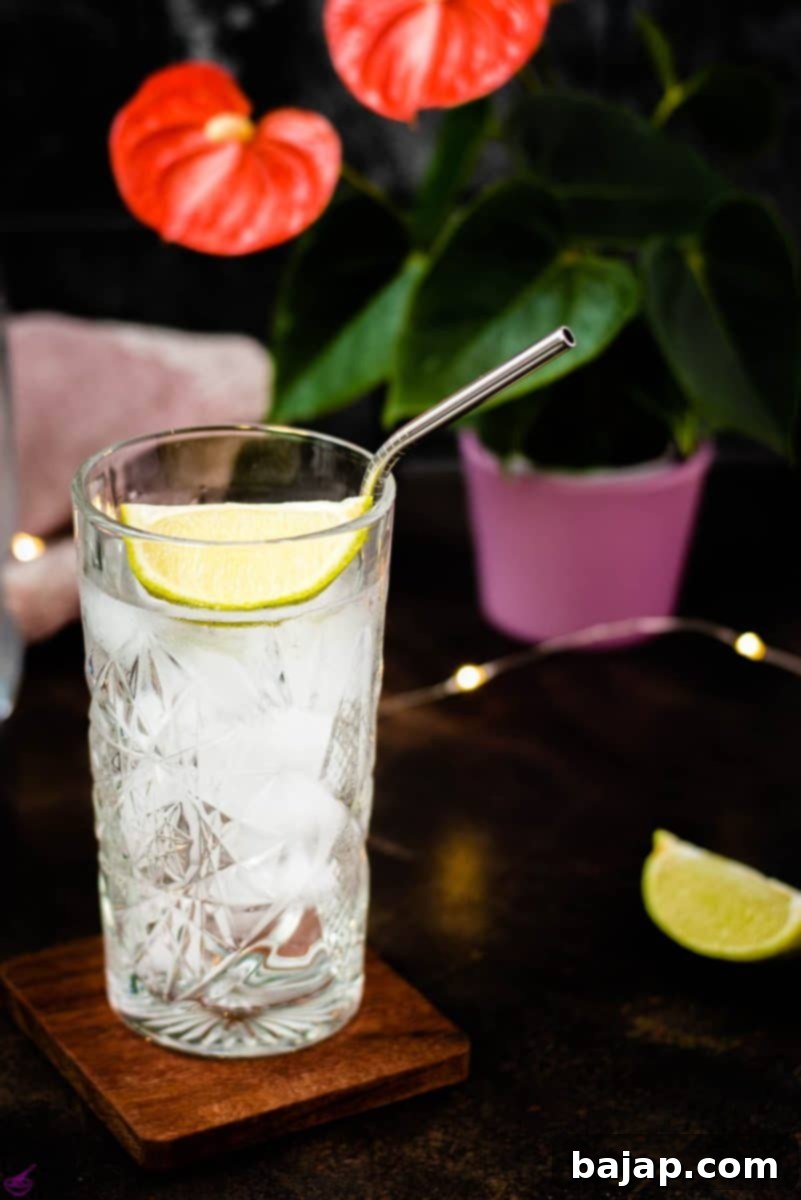
Best Pairings for Gin and Tonic
One of the many charms of the gin and tonic is its incredible versatility, not just in flavor variations but also in how beautifully it pairs with different foods and garnishes. Creating the perfect pairing enhances the overall drinking experience.
Garnishes: The Final Touch
The right garnish can dramatically transform your gin and tonic, highlighting specific botanicals in the gin or adding a refreshing twist. Traditional choices include:
- Lime Wedge or Wheel: The quintessential garnish, offering tartness and freshness that complements most gins.
- Lemon Peel or Wedge: Adds a brighter, zestier aroma, especially good with citrus-forward London Dry gins like Tanqueray Gin.
- Orange Peel or Slice: Brings a sweeter, warmer citrus note, pairing well with more aromatic or slightly sweeter gins.
Beyond the classics, don’t hesitate to experiment with more adventurous options to match the gin’s unique profile:
- Cucumber Slices: Offer a cool, refreshing element, fantastic with floral or contemporary gins.
- Rosemary Sprig: Adds an aromatic, herbaceous touch, perfect for savory or Mediterranean-inspired gins.
- Fresh Berries (e.g., raspberries, strawberries): Introduce sweetness and fruitiness, lovely with lighter, fruitier gins or flavored tonic waters.
- Grapefruit Slice: Provides a pleasant bitterness and vibrant citrus, complementing spicier gins.
- Juniper Berries: Enhance the core gin flavor with an extra aromatic boost.
Food Pairings: Elevate Your Gathering
When hosting or simply enjoying a gin and tonic, the right food pairing can create a delightful experience. The cocktail’s bitter and botanical notes make it surprisingly versatile:
- Cheeses and Berries: A fantastic combination. A well-curated charcuterie board with a mix of hard and soft cheeses, various berries (strawberries, blueberries), and cured meats makes for a perfect pre-dinner or arrival snack, complementing the G&T’s refreshing qualities.
- Seafood and Light Appetizers: The crispness of a G&T cuts through the richness of seafood beautifully. Think shrimp cocktail, smoked salmon canapés, or delicate ceviche.
- Savory Snacks: Olives, salted nuts, or even potato chips can provide a satisfying contrast to the G&T’s botanicals.
- Chocolates and Fudge: For after-dinner indulgence, dark chocolates or rich fudge offer a delightful contrast to the bitter notes and botanical flavors of a classic gin and tonic. The sweetness and intensity of chocolate can bring out unexpected depth in the gin.
- Pâté: For something a bit more unexpected, consider serving pâté. Interestingly, many pâtés are seasoned with juniper berries, the primary botanical in gin. This shared flavor profile creates a harmonious and sophisticated pairing that will impress your guests.
Gin and Tonic Ratio
Achieving the perfect gin and tonic ratio is essential for a balanced and flavorful drink. While personal preference plays a role, a general guideline ensures optimal enjoyment. For the ideal ratio of gin to tonic water, you’ll want to fill your glass with ice cubes, then pour in 1 ½ oz (4 cl / 40 ml) of gin. After adding your spirit, gently fill the remainder of the glass with tonic water. It’s crucial to use a highball glass, or a similar tall, narrow glass, to maintain the effervescence and ensure the gin to tonic doesn’t get out of whack, preserving the crispness of your cocktail.
Best Glass for Gin and Tonic – Highball
The highball glass is the vessel of choice for many mixed drinks, and it’s particularly well-suited for gin and tonics. The tall, thin design of a highball glass helps to preserve the carbonation in your tonic water for a longer period, keeping your drink sparkling and refreshing. Additionally, its shape allows for ample ice, which is critical for chilling the drink effectively without excessive dilution. While a highball is classic, a large gin “Copa de Balon” glass can also work, especially for elaborate garnishes, as its bulbous shape concentrates aromas.
🥘 Ingredients and Garnish for a Tanqueray Gin and Tonic
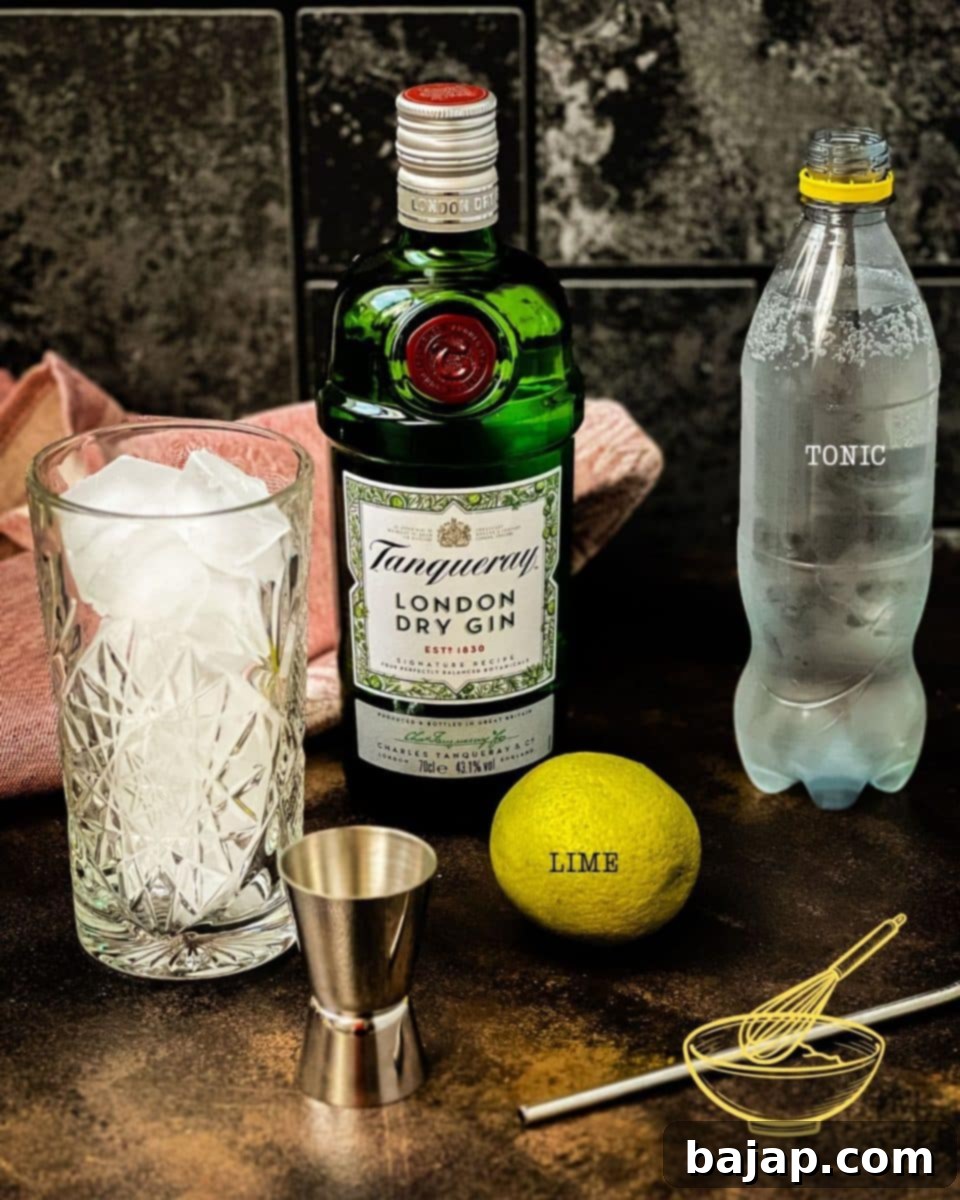
- Ice Cubes – to fill up the highball glass
- Tanqueray Gin – 1 ½ oz // 4cl // 40ml
- Tonic Water – To fill up the glass
- Fresh Lime Wedge or Wheel – for garnish
See the recipe card for quantities.
🔪 How to Make a Tanqueray Gin and Tonic
Crafting a refreshing Tanqueray Gin and Tonic Water is simple and quick. Follow these steps for the perfect serve:
- Start with a chilled highball glass. Fill it generously to the brim with quality ice cubes. This is essential for a properly cold drink and minimal dilution.
- Pour in 1 ½ oz (4 cl / 40 ml) of your Tanqueray Gin over the ice.
- Gently fill the rest of the glass with your chosen tonic water. A typical highball glass will hold anywhere from 240 to 350 ml of liquid. Pour slowly to maintain maximum carbonation.
- Garnish with a fresh lime wedge or wheel. For Tanqueray Gin, a twist of lemon zest can also beautifully complement its citrus notes. Serve immediately and enjoy!
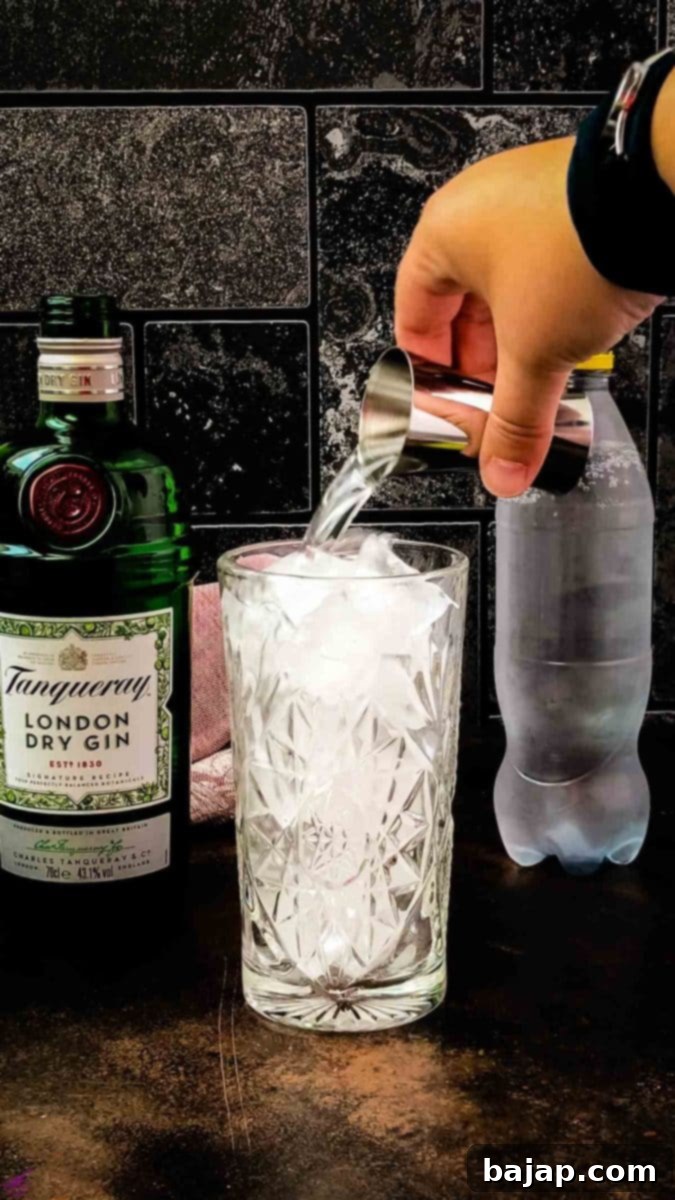
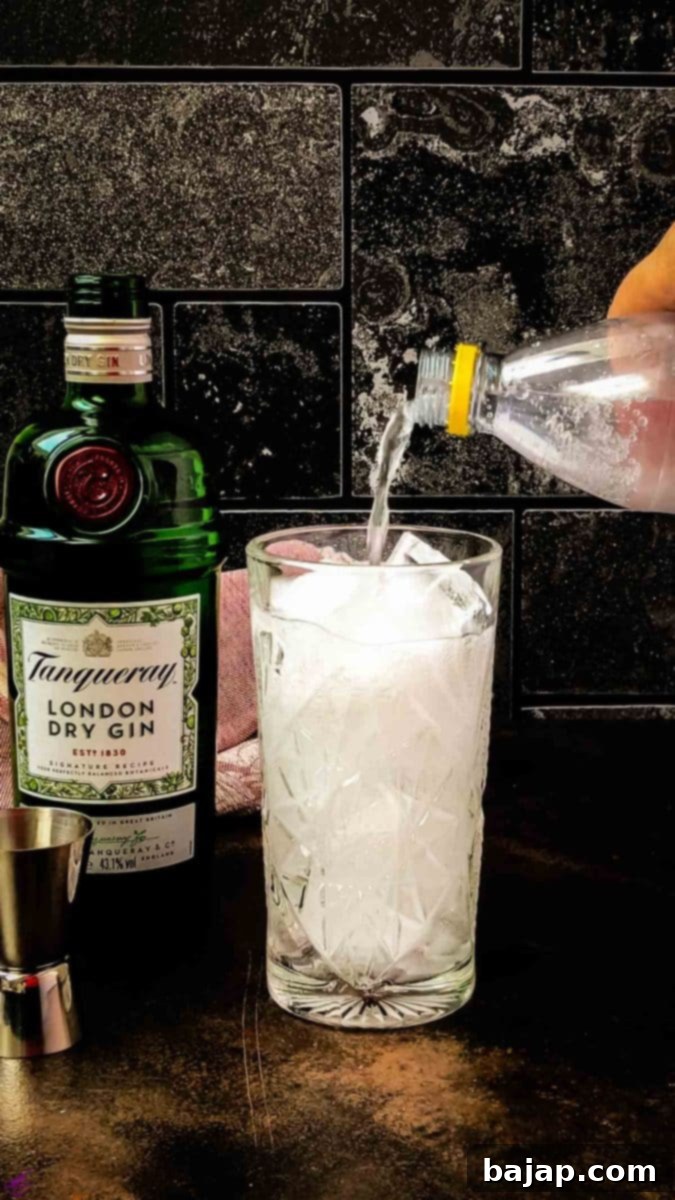
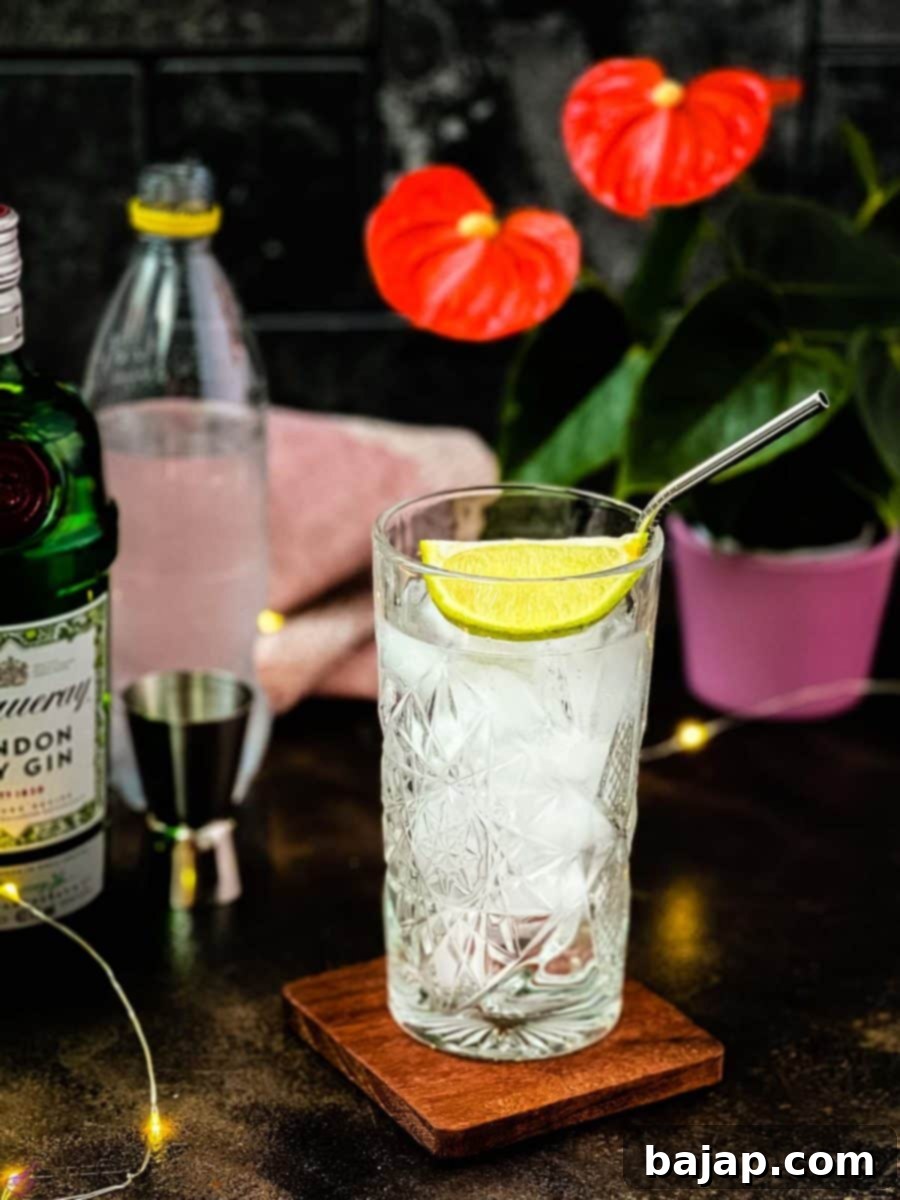
🎥 Video: How to Make a Tanqueray Gin and Tonic
🍽 Essential Equipment for Your G&T
To craft the perfect gin and tonic at home, a few basic pieces of bar equipment will make the process smooth and enjoyable:
- Jigger: For precise measurement of your gin.
- Highball glass: The ideal glass for serving, as discussed.
- Drinking straw (optional): Consider reusable options for sustainability.
💭 Top Tips for the Perfect Gin and Tonic
Creating a truly exceptional gin and tonic at home involves a few simple but crucial details:
- Chill Your Glass: When preparing your gin and tonic cocktails, always start with a chilled glass. Hold your highball glasses from the bottom to avoid touching the rim, which helps keep the glass cool. A perfectly chilled glass significantly enhances the cocktail’s taste and keeps it colder longer.
- Pre-Chill Your Glass: The most efficient way to get a perfectly chilled glass is to place them in the freezer beforehand. A minimum of half an hour is usually sufficient, but for summer gatherings, you can leave them in overnight. If freezer space is limited or you need a quicker chill between refills, fill each glass with ice cubes and let it sit for a minute or two. Dump out the ice just before building your drink.
- Quality Ice Matters: Use large, fresh ice cubes. Large cubes melt slower, preventing your drink from becoming diluted too quickly. Impure or old ice can also impart unwanted flavors.
- Fresh Ingredients: Always use fresh garnishes and high-quality tonic water. The freshness of your lime or other botanicals makes a noticeable difference.
- Gentle Stirring: Once your gin and tonic is assembled, give it a gentle stir for just a few seconds to mix the ingredients without losing too much carbonation.
- Sustainable Sips: In an attempt to protect our environment, I highly encourage you to avoid using disposable straws whenever possible. Opt for reusable metal or paper straws, or simply enjoy your G&T without one.
🙋🏻 Gin and Tonic FAQ
Typically, the standard ratio for a balanced gin and tonic is 1 part gin to 2 parts tonic water (e.g., 2 oz gin to 4 oz tonic water). However, this can be adjusted to your personal preference. Some prefer a “drier” G&T with less tonic, while others like it sweeter. Our recipe aims for a perfectly refreshing cocktail with just the right kick, but feel free to experiment!
Compared to many other spirits, gin typically contains fewer sugars and calories, particularly in its pure form. Its historical roots in medicinal purposes, thanks to botanicals like juniper, also contribute to its reputation. However, “healthiest” is relative; moderation is always key.
You should always pour your gin into the ice-filled glass first, and then gently top it off with your tonic water. This helps to properly mix the ingredients and preserves the carbonation of the tonic.
The most iconic and arguably best mix for gin is tonic water, creating the classic gin and tonic. However, gin is incredibly versatile! Popular and tasty combinations include cucumber gin and tonic with fresh cucumber slices, gin and tonic with lime, and gin and tonic with lemon, often garnished with a lemon peel. Beyond tonic, gin also pairs wonderfully with soda water, various fruit juices (like grapefruit or cranberry), and in classic cocktails such as a Martini, Negroni, or Gimlet.
Botanicals are the natural flavoring agents used in gin distillation. Juniper berries are the only mandatory botanical, providing gin with its characteristic piney flavor. Other common botanicals include coriander seeds, angelica root, citrus peels (lemon, orange), cassia bark, orris root, and licorice. Modern gins experiment with a vast array of botanicals, including floral notes (rose, lavender), herbs (rosemary, thyme), and spices (cardamom, pepper), creating diverse and complex flavor profiles.
Unopened gin should be stored upright in a cool, dark place away from direct sunlight, maintaining its quality indefinitely. Once opened, gin can last for several years without significant flavor degradation, though it’s best consumed within a year for optimal taste. Tonic water should also be stored in a cool, dark place. Once opened, it should be refrigerated and consumed within a few days to preserve its carbonation and flavor.
OTHER RECIPES FOR YOU TO TRY
How to Make a Refreshing Strawberry Spritz Cocktail
Refreshing Lavender Daiquiri
How to Make a Snowball Cocktail
Homemade Vodka Sidecar
Lovely Lavender Spritz Cocktail
If you make this recipe, let me know how you liked it by ★★★★★ star rating it and leaving a comment below. This would be awesome! You can also sign up for our Newsletter or follow me on Pinterest or Instagram and share your creation with me. Just tag me @combinegoodflavors and hashtag #combinegoodflavors, so I don’t miss it.
📖 Recipe: Tanqueray Gin and Tonic
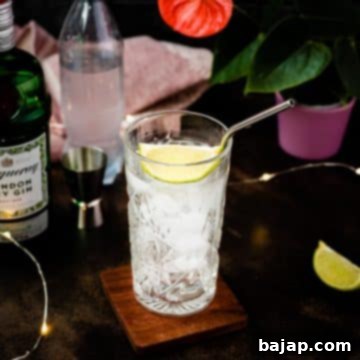
Tanqueray Gin and Tonic
Nora
Save RecipeSaved!
Pin Recipe
Equipment
-
Jigger
-
Highball Glass
Ingredients
- Cubed Ice
- 1 ½ oz Tanqueray Gin
- Tonic Water to fill up the glass
- 1 Lime wedge or slices, for garnish
Instructions
-
Fill a chilled highball glass to the brim with Cubed Ice.Cubed Ice
-
Next, add 1 ½ oz Tanqueray Gin.1 ½ oz Tanqueray Gin
-
Gently fill the rest of the glass with Tonic Water (a typical highball glass holds 240ml (1 cup) to 350ml (1 ½ cups)).Tonic Water
-
Garnish with a Lime wedge or slices. Add a drinking straw if desired.Lime wedge or slices
Notes
The glass should be filled to the rim with ice to best chill the drink and minimize dilution. Use fresh, large ice cubes for optimal results.
In an attempt to protect our environment, we avoid using disposable straws whenever possible, opting for either metal or paper straws, or simply leaving them out if we can.
Garnishes should be placed strategically, often next to the straw, so that as much aroma and flavor as possible enhance the drinking experience.
Nutrition values are estimates only, using online calculators. Please verify using your own data.

🤎 You might also like
- How do you make a Frozen Strawberry Daiquiri
- How to make a Refreshing Strawberry Spritz Cocktail
- Red Halloween Cocktail
- Homemade Vodka Sidecar
⛑️ Food Safety Considerations for Cocktails
While making cocktails, general food safety practices ensure an enjoyable and safe experience. Here are a few points to keep in mind:
- Fresh Ingredients: Always use fresh fruit, herbs, and other garnishes. Wash them thoroughly before use.
- Cleanliness: Ensure all bar tools, glasses, and surfaces are clean before preparing drinks.
- Ice Handling: Use clean ice scoops or tongs. Avoid touching ice directly with your hands.
- Storage: Store all ingredients, especially perishable ones like juices and garnishes, properly refrigerated.
- Alcohol Consumption: Drink responsibly and in moderation. Know your limits and never drink and drive.
For further information on safe food handling in general, check Safe Food Handling – FDA.
